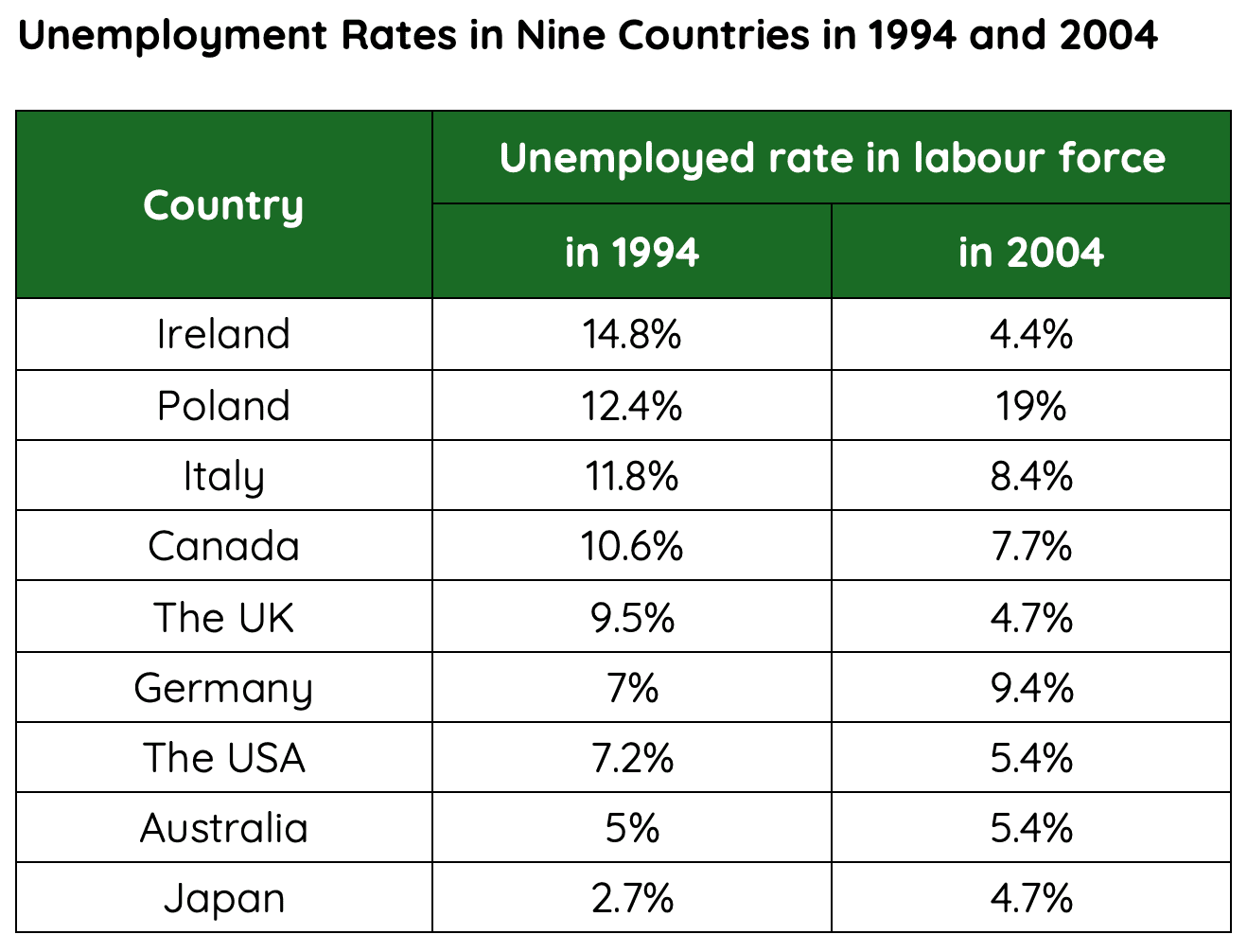Chữa đề IELTS Writing task 1 Unemployment rates in nine countries
Danh mục chính
Chữa đề IELTS Writing task 1 dạng table nhiều số liệu Unemployment rates in nine countries cùng VNUK nhé.
Đề bài:
The table below shows the percentage of unemployed people in the total labour force across nine countries in 1994 and 2004.
Summarise the information by selecting and reporting the main features and make comparisons where relevant.

1. Phân tích đề bài và lập dàn ý
Phân tích đề bài
- Loại biểu đồ: Table (dynamic chart) – hiển thị dữ liệu thay đổi theo thời gian (1994 và 2004).
- Dữ liệu: Tỷ lệ phần trăm người thất nghiệp trong lực lượng lao động tại 9 quốc gia (Ireland, Poland, Italy, Canada, the UK, Germany, the USA, Australia, Japan).
- Yếu tố cần lưu ý:
- Xu hướng chung: Xác định quốc gia nào có tỷ lệ thất nghiệp cao nhất/thấp nhất trong từng năm và sự thay đổi qua thời gian.
- So sánh hợp lý: So sánh giữa các quốc gia hoặc giữa hai mốc thời gian (1994 và 2004), tránh liệt kê số liệu một cách máy móc.
- Không đi sâu chi tiết: Chỉ chọn các điểm nổi bật (ví dụ: sự thay đổi lớn, quốc gia có tỷ lệ cao/thấp nhất).
- Ngôn ngữ: Sử dụng từ vựng mô tả xu hướng (tăng, giảm, ổn định) và cấu trúc so sánh.
Dàn ý tham khảo
- Introduction: Diễn đạt lại đề bài (paraphrase) một cách tự nhiên, giới thiệu nội dung bảng.
- Overview: Tóm tắt các xu hướng chính (ví dụ: quốc gia có tỷ lệ cao/thấp nhất, xu hướng chung của tỷ lệ thất nghiệp).
- Body Paragraph 1: Mô tả tỷ lệ thất nghiệp năm 1994 và so sánh giữa các quốc gia (tập trung vào cao nhất/thấp nhất).
- Body Paragraph 2: Mô tả tỷ lệ thất nghiệp năm 2004 và sự thay đổi so với 1994 (tập trung vào xu hướng tăng/giảm đáng chú ý).
2. Sample Answers
1. Sample answer band 6.0 - 6.5
The table gives information about the percentage of unemployed people in the labour force in nine countries in 1994 and 2004.
Overall, there are some changes in unemployment rates in these countries. In 1994, some countries had high rates, but in 2004, most rates went down. Ireland and Japan had big changes.
In 1994, Ireland had the highest unemployment rate at 14.8%, followed by Poland at 12.4%. Italy and Canada also had high rates, with 11.8% and 10.6%. The lowest rate was in Japan, at only 2.7%. Other countries like the UK (9.5%) and the USA (7.2%) were in the middle.
By 2004, the unemployment rate in Ireland dropped a lot to 4.4%, which is a big decrease. Poland, however, increased to 19%, the highest in this year. The UK and Japan both had 4.7%, which is low. Germany went up to 9.4% from 7%, while the USA and Australia stayed almost the same at 5.4%.
2. Sample answer Band 7.5 - 8.0
The table presents data on the unemployment rates within the labour force across nine countries in 1994 and 2004.
Overall, the data reveals a general decline in unemployment rates over the decade, with Ireland and Poland showing the most significant shifts. While Japan consistently maintained the lowest rates, Poland experienced a dramatic rise by 2004.
In 1994, Ireland recorded the highest unemployment rate at 14.8%, closely followed by Poland at 12.4% and Italy at 11.8%. Canada and the UK also exhibited relatively high figures, at 10.6% and 9.5% respectively. In contrast, Japan had the lowest rate at 2.7%, with Australia (5%) and the USA (7.2%) occupying intermediate positions.
By 2004, Ireland's unemployment rate plummeted to 4.4%, marking a substantial improvement. Conversely, Poland saw a striking increase to 19%, becoming the highest in the period. The UK and Japan both stabilized at 4.7%, while Germany rose slightly from 7% to 9.4%. The USA and Australia remained relatively stable, with rates of 5.4%, reflecting minimal change over the decade.
Từ vựng IELTS hữu ích
- Unemployment: Tỷ lệ thất nghiệp
- Labour force: Lực lượng lao động
- Decline: Giảm
- Plummet: Giảm mạnh
- Rise: Tăng
- Stabilize: Ổn định
- Significant: Đáng kể
- Striking: Nổi bật, ấn tượng
- Intermediate: Trung bình
- Conversely: Ngược lại
- Substantial: Đáng kể (về mức độ)
- Exhibit: Thể hiện
